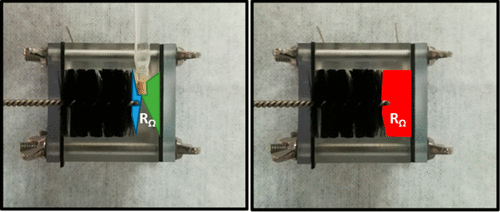当前位置:
X-MOL 学术
›
Environ. Sci. Technol.
›
论文详情
Our official English website, www.x-mol.net, welcomes your
feedback! (Note: you will need to create a separate account there.)
Impact of Ohmic Resistance on Measured Electrode Potentials and Maximum Power Production in Microbial Fuel Cells
Environmental Science & Technology ( IF 10.8 ) Pub Date : 2018-07-17 , DOI: 10.1021/acs.est.8b02055 Bruce E. Logan 1 , Emily Zikmund 1 , Wulin Yang 1 , Ruggero Rossi 1 , Kyoung-Yeol Kim 1 , Pascal E. Saikaly 2 , Fang Zhang 3
Environmental Science & Technology ( IF 10.8 ) Pub Date : 2018-07-17 , DOI: 10.1021/acs.est.8b02055 Bruce E. Logan 1 , Emily Zikmund 1 , Wulin Yang 1 , Ruggero Rossi 1 , Kyoung-Yeol Kim 1 , Pascal E. Saikaly 2 , Fang Zhang 3
Affiliation

|
Low solution conductivity is known to adversely impact power generation in microbial fuel cells (MFCs), but its impact on measured electrode potentials has often been neglected in the reporting of electrode potentials. While errors in the working electrode (typically the anode) are usually small, larger errors can result in reported counter electrode potentials (typically the cathode) due to large distances between the reference and working electrodes or the use of whole cell voltages to calculate counter electrode potentials. As shown here, inaccurate electrode potentials impact conclusions concerning factors limiting power production in MFCs at higher current densities. To demonstrate how the electrochemical measurements should be adjusted using the solution conductivity, electrode potentials were estimated in MFCs with brush anodes placed close to the cathode (1 cm) or with flat felt anodes placed further from the cathode (3 cm) to avoid oxygen crossover to the anodes. The errors in the cathode potential for MFCs with brush anodes reached 94 mV using acetate in a 50 mM phosphate buffer solution. With a felt anode and acetate, cathode potential errors increased to 394 mV. While brush anode MFCs produced much higher power densities than flat anode MFCs under these conditions, this better performance was shown primarily to result from electrode spacing following correction of electrode potentials. Brush anode potentials corrected for solution conductivity were the same for brushes set 1 or 3 cm from the cathode, although the range of current produced was different due to ohmic losses with the larger distance. These results demonstrate the critical importance of using corrected electrode potentials to understand factors limiting power production in MFCs.
中文翻译:

欧姆电阻对微生物燃料电池中测得的电极电势和最大发电量的影响
已知溶液电导率低会不利地影响微生物燃料电池(MFCs)的发电,但是在电极电势的报告中,它对测得的电极电势的影响通常被忽略。尽管工作电极(通常是阳极)中的误差通常很小,但较大的误差可能会导致报告的反电极电位(通常是阴极),这是由于参比电极和工作电极之间的距离较大或使用整个电池电压来计算反电极潜力。如此处所示,不正确的电极电势会影响有关在较高电流密度下限制MFC中功率产生的因素的结论。为了演示应如何使用溶液电导率来调整电化学测量,电极中的电势是在MFC中估算的,其中刷式阳极靠近阴极(1厘米),或者平毡阳极远离阴极(3厘米),以避免氧气交叉进入阳极。在50 mM磷酸盐缓冲溶液中使用乙酸盐时,带刷阳极的MFC的阴极电位误差达到94 mV。使用阳极毡和醋酸纤维毡时,阴极电位误差增加到394 mV。尽管在这些条件下,电刷阳极MFC的功率密度比平面阳极MFC高得多,但显示出这种更好的性能主要是由于电极电位校正后的电极间距所致。经过溶液电导率校正的电刷阳极电势与距阴极1或3 cm的电刷组相同,尽管由于较大距离下的欧姆损耗,产生的电流范围有所不同。
更新日期:2018-07-18
中文翻译:

欧姆电阻对微生物燃料电池中测得的电极电势和最大发电量的影响
已知溶液电导率低会不利地影响微生物燃料电池(MFCs)的发电,但是在电极电势的报告中,它对测得的电极电势的影响通常被忽略。尽管工作电极(通常是阳极)中的误差通常很小,但较大的误差可能会导致报告的反电极电位(通常是阴极),这是由于参比电极和工作电极之间的距离较大或使用整个电池电压来计算反电极潜力。如此处所示,不正确的电极电势会影响有关在较高电流密度下限制MFC中功率产生的因素的结论。为了演示应如何使用溶液电导率来调整电化学测量,电极中的电势是在MFC中估算的,其中刷式阳极靠近阴极(1厘米),或者平毡阳极远离阴极(3厘米),以避免氧气交叉进入阳极。在50 mM磷酸盐缓冲溶液中使用乙酸盐时,带刷阳极的MFC的阴极电位误差达到94 mV。使用阳极毡和醋酸纤维毡时,阴极电位误差增加到394 mV。尽管在这些条件下,电刷阳极MFC的功率密度比平面阳极MFC高得多,但显示出这种更好的性能主要是由于电极电位校正后的电极间距所致。经过溶液电导率校正的电刷阳极电势与距阴极1或3 cm的电刷组相同,尽管由于较大距离下的欧姆损耗,产生的电流范围有所不同。











































 京公网安备 11010802027423号
京公网安备 11010802027423号